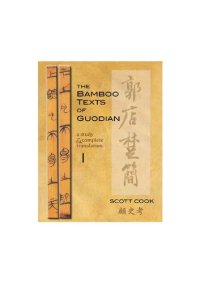
Ebook: The Bamboo Texts of Guodian: A Study and Complete Translation
Author: Scott Cook
- Series: Cornell East Asia Series, 164
- Year: 2013
- Publisher: Hawaii Distributed Titles
- Edition: Annotated
- Language: English
- pdf
The cache of bamboo texts recently unearthed (in 1993) from the village of Guodian, Hubei Province, is without doubt a rare and unique find in the history of Chinese philosophy and literature. As the only archaeologically excavated corpus of philosophical manuscripts to emerge from a Warring States–period tomb, the Guodian texts provide us with a wealth of reliable information for gaining new insights into the textual and intellectual history of pre-imperial China. In this respect, one may reasonably claim that they are the most exciting thing to happen to the study of early China since the third century ad, the last time a pre-imperial textual cache of similar import was unearthed.
The importance of these texts is manifold. First, given the prominence of Confucian works in the corpus, they serve to fill out much of the intellectual-historical picture for the doctrines of roughly three generations of Confucian disciples who fell between the times of Confucius (551–479 bc) and Mencius (ca. 390–305 bc). Next, the discovery of three different texts that each parallel portions of the Daode jing (aka. Laozi), along with a possibly related cosmogonic work, the “Taiyi sheng shui”, is helping us better understand the formation and early transmission of the Laozi and the nature of its relationship to early Confucian thought and even popular beliefs. Moreover, the dating of the tomb serves to dispel serious doubts about the early temporal provenance of both the Laozi and many of the chapters from the Li ji (Book of Ritual), as well as giving us a number of clues to help us reconstruct the history of the early Chinese canonical “classics” that are cited in some of the texts.
Written as they are in the local Chu script, the manuscripts hold great significance for the study of early Chinese paleography and phonology, giving us tangible examples of “ancient script” forms hitherto seen mainly in early character dictionaries and a limited array of technical manuscripts previously excavated from the region.
Volume I presents a general introduction to the Guodian tomb, the manuscript contents, and a discussion of the various problems of reading and interpretation that the manuscripts involve, along with their place within the larger context of early Chinese intellectual history. It also contains introductions to and annotated translations of the “Laozi” and “Taiyi sheng shui” manuscripts, along with those of “Ziyi,” “Lu Mu Gong wen Zisi,” “Qiongda yi shi,” “Wu xing,” “Tang Yu zhi dao,” and “Zhongxin zhi dao.”
The importance of these texts is manifold. First, given the prominence of Confucian works in the corpus, they serve to fill out much of the intellectual-historical picture for the doctrines of roughly three generations of Confucian disciples who fell between the times of Confucius (551–479 bc) and Mencius (ca. 390–305 bc). Next, the discovery of three different texts that each parallel portions of the Daode jing (aka. Laozi), along with a possibly related cosmogonic work, the “Taiyi sheng shui”, is helping us better understand the formation and early transmission of the Laozi and the nature of its relationship to early Confucian thought and even popular beliefs. Moreover, the dating of the tomb serves to dispel serious doubts about the early temporal provenance of both the Laozi and many of the chapters from the Li ji (Book of Ritual), as well as giving us a number of clues to help us reconstruct the history of the early Chinese canonical “classics” that are cited in some of the texts.
Written as they are in the local Chu script, the manuscripts hold great significance for the study of early Chinese paleography and phonology, giving us tangible examples of “ancient script” forms hitherto seen mainly in early character dictionaries and a limited array of technical manuscripts previously excavated from the region.
Volume I presents a general introduction to the Guodian tomb, the manuscript contents, and a discussion of the various problems of reading and interpretation that the manuscripts involve, along with their place within the larger context of early Chinese intellectual history. It also contains introductions to and annotated translations of the “Laozi” and “Taiyi sheng shui” manuscripts, along with those of “Ziyi,” “Lu Mu Gong wen Zisi,” “Qiongda yi shi,” “Wu xing,” “Tang Yu zhi dao,” and “Zhongxin zhi dao.”
Download the book The Bamboo Texts of Guodian: A Study and Complete Translation for free or read online
Continue reading on any device:

Last viewed books
Related books
{related-news}
Comments (0)